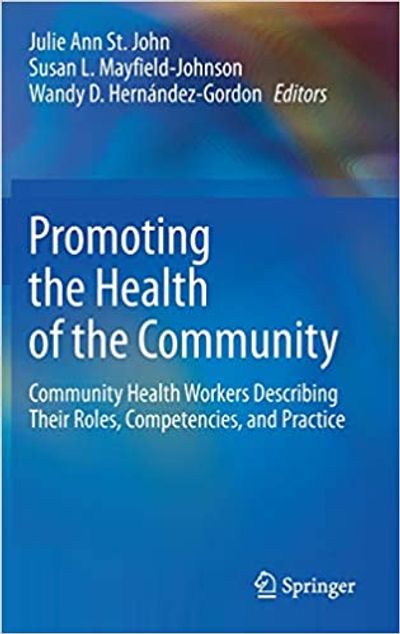Incubator for a multicultural California Association of Community Health Workers
Promoting the health of the community
Community Health Workers as Stakeholders in Research
Book title: Promoting the Health of the Community – Community Health Workers Describing Their Roles, Competencies, and Practice
Section: Participating in Evaluation and Research
Chapter title (14c): Community Health Workers as stakeholders in research: Training CHWs in Patient Centered Research and Their Impact on Clinical Trial Interventions, Brendaly Rodríguez, Carmen Linarte, Olveen Carrasquillo
here are the Links:
https://www.springer.com/gp/book/9783030563745
https://www.amazon.com/Promoting-Health-Community-Describing-Competencies/dp/303056374X
Contact:
Brendaly Rodríguez, MA, CPH | Director
Chula Vista Community Collaborative
540 G Street, Chula Vista CA 91910
(619) 427-2290 Brendaly.Rodriguez@cvesd.org

Patient Centerted Outcomes research institute (PCORI)
COMMUNITY HEALTH WORKERS (CHWS) IN PATIENT CENTERED OUTCOMES RESEARCH (PCOR) IN THE CONTEXT OF COVID
Background
Community Health Workers are an important PCOR stakeholder group. With PCORI support, over the last five years we have developed curricula to train CHW to participate as part of PCOR research teams. However, the current COVID pandemic with requirements for social distancing and less face to face interaction is having a profound effect in on PCOR research. Our teams have already mobilized CHWs to address some of these challenges. Based on our experience and expertise, our goal now is to increase CHW capacity to continue to participate across all phases of the PCOR by developing additional CHW abilities for virtual and distanced methods of PCOR engagement.
The four key collaborators in this project are
- Chula Vista Community Collaborative (California)
- Dia de la Mujer Latina (Texas)
- Florida Community Health Worker Coalition
- University of Miami (UM)
These community partners had successfully developed a 7-hr specialized toolkit on patient-centered research for CHWs and trained over 600 CHWs/promotores across 3 states. They would also create a Spanish version of the training.
Goal:
By mobilizing and engaging CHWs/promotores as stakeholders, to promote the capacity for CHWs participating in patient centered research (PCOR) in the context of COVID by locally implementing a structured research training curriculum for CHWs in English and Spanish. By increasing awareness and demystifying such tools we hope increase their capacity to be effective members of PCOR teams whom had to adapt to contextual realities of the COVID pandemic.
Objectives
1. Work with stakeholder partners in three states (California, Florida and Texas) to develop a training curriculum for PCOR through virtual/distanced methods of engagement
2. Using distance learning and Train-the-Trainer model, train 10 champions (4 CA, 4 TX, 2 Fl) with the curriculum.
3. Create a Spanish version of the training program. (at least one champion per state will be fluent in Spanish)
4. The ten champions will train 20 CHWs each in PCOR in their state through video conferencing. (200 total)
5. With a focus on long-term sustainability develop an online CHW PCOR telehealth training module which we would add to our existing online toolkit.
Role of Advisory Group:
A twelve-person stakeholder panel will review the initial iteration of the curriculum and based on bidirectional feedback we would develop a draft that would then be presented to CHWs focus group for additional input.
Project Lead: Olveen Carrasquillo, MD MPH.
Project Co-Lead: Brendaly Rodríguez, MA CPH at brendaly.rodriguez@cvesd.org.
The Patient Centered Outcomes Research Institute (PCORI) is an independent research institute that helps people make informed healthcare decisions, and improves healthcare delivery and outcomes, by producing and promoting evidence-based information. For more information please visit: www.pcori.org

CHW Central and HSG
Webinar- Recording From : Feb 16 2021
Enhancing Community Health Research By Engaging Community Health Workers
California Primary CAre Association
Additional Information
This live event occurred on May 30, 2017;
RECORDING: to access a copy of the recording
NEW! Community Health Worker & Promotora Trainings!
CPCA is offering this multi-part training program to introduce health centers and regional associations to a new workforce; community health workers (CHWs) and Promotoras who can be integrated into a clinic to help provide a more holistic approach when caring for patients.
Community health workers are widely utilized in low income communities and are an important tool in reducing health disparities; however, evidence is lacking on their effectiveness, making it difficult for such programs to receive funding.
Given the diversity of CHW programs, there is no one-size-fits-all evaluation approach. CHW programs may hire an external evaluator or assign an internal staff member to serve as an evaluator. In developing an evaluation plan, evaluators of CHW programs emphasize the importance of employing simple data collection techniques and using existing data tracking mechanisms, like electronic health records.
Please join us for the last webinar of our series as we review different data collection methods that clinics can utilize to demonstrate the impact that CHWs are having in improving health outcomes for patients and the community.
LEARNING OBJECTIVES
- Learn the importance of, and best practices for data collection.
- Acquire different methods of data collection that can help fund your CHW/Promotora program.
- Gain an understanding of how to collect evidence-based data to help show a return on investment.
SPEAKERS
- Evelyn Gonzalez, Policy Director, Community Health Councils
- Bonnie Hough, Health Center and Program Policy Analyst, MHP Salud
- Laura Miller, MD, Chief Medical Officer, Community Health Center Network
- Angela O'Brien, LCSW, Social Work Supervisor, Care Neighborhood

